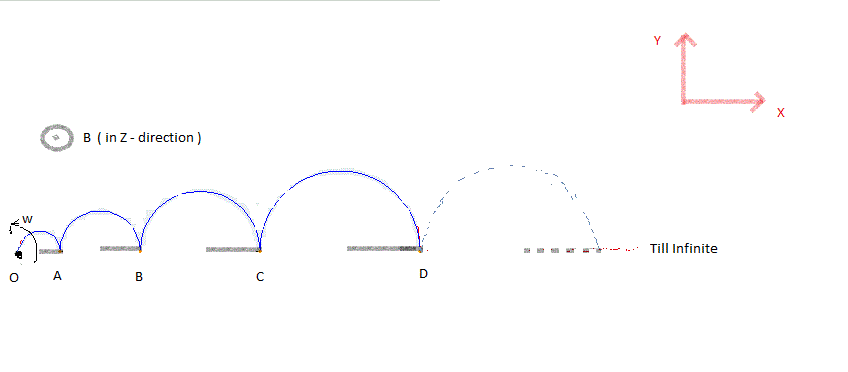Magnetism + Sequence = Maquence
 An infinitely long, thin, conducting rod is
bent
in the form of semi-circular rings,
as shown in the figure. Now it is placed in a uniform magnetic field of magnitude
B
0
oriented perpendicular to the plane of the rings.
An infinitely long, thin, conducting rod is
bent
in the form of semi-circular rings,
as shown in the figure. Now it is placed in a uniform magnetic field of magnitude
B
0
oriented perpendicular to the plane of the rings.
The radii of the successive half rings are as follows: R , 3 R 2 , 5 R 3 , 7 R 4 … ∞
Now if we rotate the Rod about the point O with constant angular velocity ω , find the magnitude of the induced emf developed in the rod.
Assumptions
- The rod is very thin.
- The rod is rigid.
Details
- B 0 = 2 . 0 Tesla
- ω = 5 rad/sec
- R = 0 . 5 m
This is Original
Try more mixing of concepts
The answer is 180.
This section requires Javascript.
You are seeing this because something didn't load right. We suggest you, (a) try
refreshing the page, (b) enabling javascript if it is disabled on your browser and,
finally, (c)
loading the
non-javascript version of this page
. We're sorry about the hassle.
2 solutions
There is one more method to solve it namely that we can imagine rods being placed at the place of diameters and as it is a rigid body, we can find the successive increase in potential and sum it to get a G.P. But, we don't get the same answer. So, how is one method more "right" than the other. This solution or Leff one?
Log in to reply
That is also Correct Method ! And Also give same answer But In that case you can't use directly that :
E k = 2 B ω L k 2 .
Because when yo derived this relation by integration then You must have to put limits from the point about which system is rotated !!
For eg: Emf between K t h Rod is given by ;
E k = B ω ∫ a b x d x .
where :
a = 2 n = 1 ∑ n = K − 1 ( 2 n − 1 ) R n .
b = 2 n = 1 ∑ n = K ( 2 n − 1 ) R n .
So this also give same Answer!
Log in to reply
Yeah..that's what I was saying that we should arrive at the same answer using both the methods.....Probably made some mistake in calculations...
Thanks @Deepanshu Gupta for pointing out the key point in the alternate approach. I also did the same mistake.
My calculation !! Darn it !
The problem is good but overrated
This system is Analogous To an rod rotating with angular velocity ' ω .' and has Length equal to sum of diameters of all rings. Let it's Length is 'L' then L = 2 ( R + 3 R 2 + 5 R 3 + 7 R 4 . . . . . . . . . . . . . . ∞ ) ⟶ ( 1 ) R L = 2 ( R 2 + 3 R 3 + 5 R 4 . . . . . . . . . . . . . . ∞ ) ⟶ ( 2 ) ⇒ ( 1 − R ) L = 2 ( R + 2 R 2 + 2 R 3 + 2 R 4 . . . . . . . . . . . . . . ∞ ) .
Now it is GP A f t e r S e c o n d T e r m so it's sum can be determined easily Therefore:
L = ( 1 − R ) 2 2 R ( 1 + R ) .
Now Total emf induced can be written as:
⇒ E i n d = 2 1 B ω ( L e f f 2 ) ⇒ L e f f = ( 1 − R ) 2 2 R ( 1 + R ) ⇒ E i n d = 2 B ω ( ( 1 − R ) 2 R ( 1 + R ) ) 2 .
Now Put The Values and Get The Answer.
A N S = 1 8 0 .